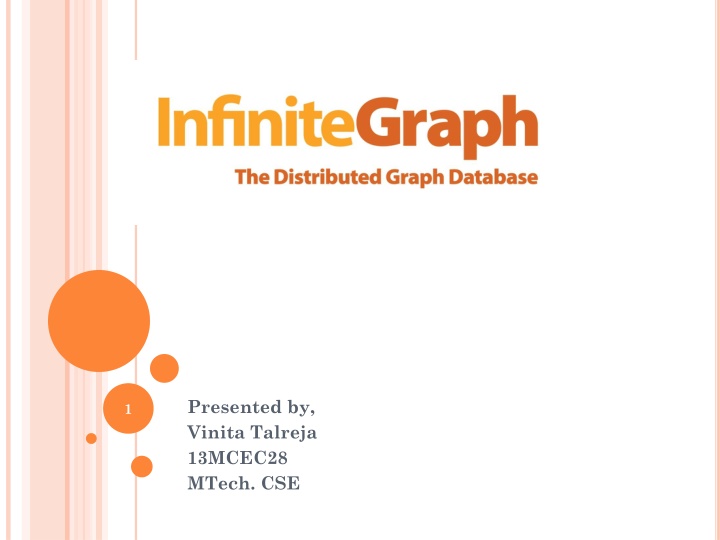
Technical Specifications and Database Creation in InfiniteGraph
Explore the basic architecture, technical specifications, and processes involved in creating and using databases with InfiniteGraph. Learn about the flexible consistency, indexing, and persistence options offered, along with the importance of boot files and data addition procedures.
Download Presentation

Please find below an Image/Link to download the presentation.
The content on the website is provided AS IS for your information and personal use only. It may not be sold, licensed, or shared on other websites without obtaining consent from the author. If you encounter any issues during the download, it is possible that the publisher has removed the file from their server.
You are allowed to download the files provided on this website for personal or commercial use, subject to the condition that they are used lawfully. All files are the property of their respective owners.
The content on the website is provided AS IS for your information and personal use only. It may not be sold, licensed, or shared on other websites without obtaining consent from the author.
E N D
Presentation Transcript
Presented by, Vinita Talreja 13MCEC28 MTech. CSE 1
BASIC ARCHITECTURE User Apps Blueprints IG Core/API Session / TX Managemen t Managemen t Extensions Navigation Execution Configuratio n Placement Objectivity/DB Distributed Database 2
TECHNICAL SPECIFICATIONS Written in: Java (core C++) Platforms: Windows (32-bit and 64-bit), Linux (32-bit and 64-bit), Mac (64-bit) API/Protocols: Java, Tinkerpop (which provides Gremlin, REST, Frames, Ripple and Linked Process) Consistency: Flexible (from ACID, to relaxed) Indexing: Flexible (from automatic to manual) Persistence: Java class based. 3
CREATINGA DATABASE GraphFactory.create(dbname) GraphFactory.create(dbname,propertiesfile) Fig: Files created on creation of database Ref: https://wiki.infinitegraph.com 4
BOOTFILE The boot file (mySystemName.boot) includes all the information needed to open a graph database. When an application interacts with a graph database, it establishes the connection through the boot file. The boot file lists the location of the graph's system database file (mySystemName.fdb), which is a binary file that stores information about your graph. 5
USINGTHEDATABASE GraphFactory.open(dbname) GraphFactory.open(dbname,propertiesfile) 6
ADDINGDATA The first time persistent elements are added to the graph, DATABASE files are created to store those elements, and the locations of those database files are added to the system database file. The schema definitions for the elements are also added to the system database file. Each new persistent element is given a unique identifier and stored in the appropriate database file (handled by InfiniteGraph's managed placement system). As applications make updates to the graph, JOURNAL files are created. These files are used to return the graph to its previously committed state if a transaction is aborted or terminated abnormally. 7
8 Fig: Files Ref: http://wiki.infinitegraph.com/
SYSTEM FILES Vertex instances are placed in VertexGroup_n.systemName.DB Edge instances are placed in EdgeGroup_n.systemName.DB Internal information related to edges is stored in ConnectorGroup_n.systemName.DB. 9
ADDVERTICESANDEDGES Vertex vinita= myGraph.addVertex(new Person( Vinita )); Vertex shalini = myGraph.addVertex(new Person( Shalini )); Vertex shraddha= myGraph.addVertex(new Person( Shraddha )); Vertex rajvi= myGraph.addVertex(new Person( Rajvi )); vinita.addEdge(new Meeting( Denver , 5-27-10 ), shalini); shalini.addEdge(new Call(timestamp), shraddha); shraddha.addEdge(new Payment(100000.00), rajvi); shalini.addEdge(new Call(timestamp), rajvi); Shalin i Shrad dha Vinita Rajvi Meets Calls Pays Calls 10
LOCAL DATA ACCESS 11 Fig: Local Data Access Ref: https://wiki.infinitegraph.com
REFERENCES https://wiki.infinitegraph.com Whitepaper: InfiniteGraph: The Distributed Graph database 13
THANK YOU! 14
